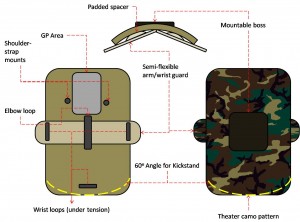Since this is the first Free Idea post, please click the menu item above to learn what this category is all about.
Working Name: Impact
Descriptive Name: Infantry Ballistic Shield
Date Conceived: No date listed, though certainly between 1998 and 2001 with minor aspects coming along a little later
Story
Circumstances or Problem
At the time that I came up with this, I was a Marine Sergeant tasked with creating a three-part urban warfare Powerpoint class. In retrospect, I probably went into too much detail on theory and should have spent more time on the “What exactly do I do” material. The urban environment had proven to be a difficult tactical problem, almost regardless of how much studying on it I did, and I did a lot. Virtually any pocket anywhere could spell death for an operator moving through it. It seemed to border on suicidal just entering rooms or walking down hallways. Every tactical problem I tried to solve with a team or squad could have been made magnitudes easier with some portable cover.
Exploring the Solution
I realized that there was a zone system (perhaps a future post) which was based on the arcs connecting the operator to cover and then to the enemy. I came to the conclusion that the infantryman needed ballistic protection above a vest and helmet. They needed portable cover that could take repeated impacts, since the environmental cover available was so unpredictable, some rigid, some porous, some large, some small. It needed to be able to protect the user and at least one other person, but the user had to be able to fulfill their mission, which was tied to their weapon.
This seemed reasonable since a rifle requires little arm swing to operate (as compared to the weapons for which shields were first developed). I looked into what SWAT, ATF, and other urban assault units used, but their ballistic shields didn’t answer all of my concerns. Some, frankly, were just too heavy for the already loaded-down operator who wouldn’t be carrying this for 15 mins, but for days on end. Some were light but limited weapon operation and were not part of a concealment plan.
Developing the Solution
The shield needed to meet three criteria:
1) The user must be able to operate a two-handed weapon while the shield is employed.
2) It must be lighter than the weapon carried, easily stowed, and easily put into service.
3) It must be modular and have replaceable components, thus able to adapt to wear and tear and changing missions.
Concept
Impact is an arc of three replaceable layers of Dyneema (45 degrees at 40″) in three heights (~14″, ~28″, and ~36″) nested snuggly in a flexible Kevlar jacket that buttons closed. The bottom is sliced along a plane at between 6 and 10 degrees from horizontal. A 4 inch square hole is cut into the center where a 1/2 inch thick, 5.5 square inch rolled steel boss is mounted on the outside with four heavy bolts. A Kevlar arm pad is on the inside, which extends horizontally left and right slightly beyond the edge of the shield.
The center of mass of the boss is 1-3 inches forward of the elbow. Retaining straps, affixed to loops in the jacket several inches from the top, attach to the shoulder loops of a standard vest, which must be reinforced to avoid pulling the vest uncomfortably up under the chin. In this way, the shield can be worn on the back, the top of which should be a few inches above the base of the back of the helmet when standing or sitting. A quick-release on each strap allows one side or the other to become very loose, permitting the strap to fall forward over the shoulder and the shield to be deployed rapidly on either side.
The Dyneema can be replaced after a requisite number of hits by disassembly. The jacket can as well. The boss is, for all intents, indestructible, but can be replaced with various options including but not limited to:
-Tazer
-Sharp (steel spike that gets wider and sharper at the base)
-Blinder (high-output plexiglass light with strobe settings)
Apart from its tactical application, it has many other simple uses. It can be used as a small back/neck litter, or two can be connected to make a large one. It can be used as a field expedient table, shelter cover, or a wet/cold weather seat. Because the main part of the unit is Dyneema, the shield floats so it can act as a flotation device for personnel or equipment.
A small dry erase board with a possible low-light red LED could be mounted on the back. A kickstand could be installed so that it would be freestanding. With a hole-stitched camouflage layer around the Kevlar, it can be camouflaged in the same manner as helmets and vests (where appropriate).
Developed
A team from SWAT visited my neighborhood and I took a chance and told one of them about just aspect number 1. Six months later I saw that characteristic on the site I checked for ballistic shield specs. I’m not aware of further development, nor have I seen the other two un-mentioned characteristics elsewhere.
Application
This clearly only has one application: militaria, general infantry, specifically as they are the most vulnerable. It was my intention that 1:2-6 Marines carry one, depending their mission, which would also determine the size of the shield and the nature of the boss.

